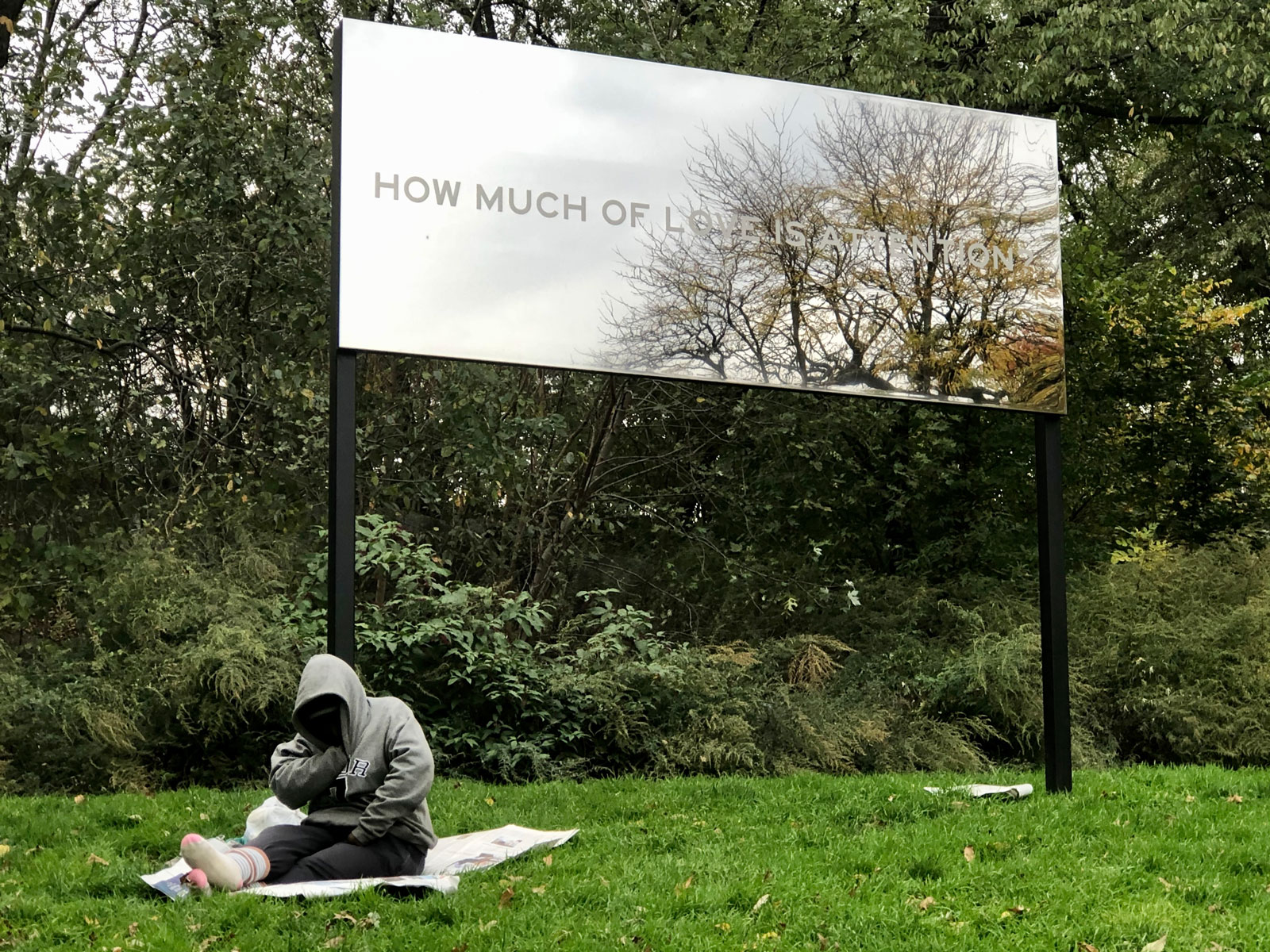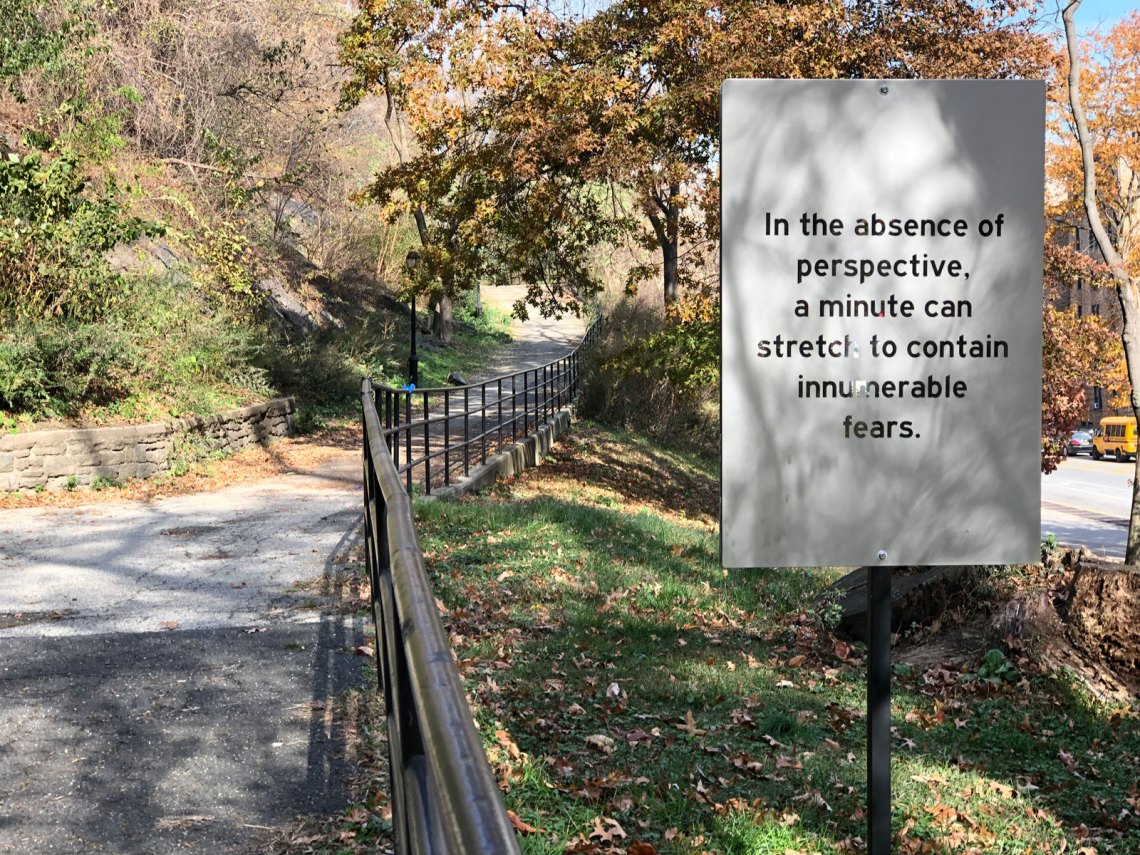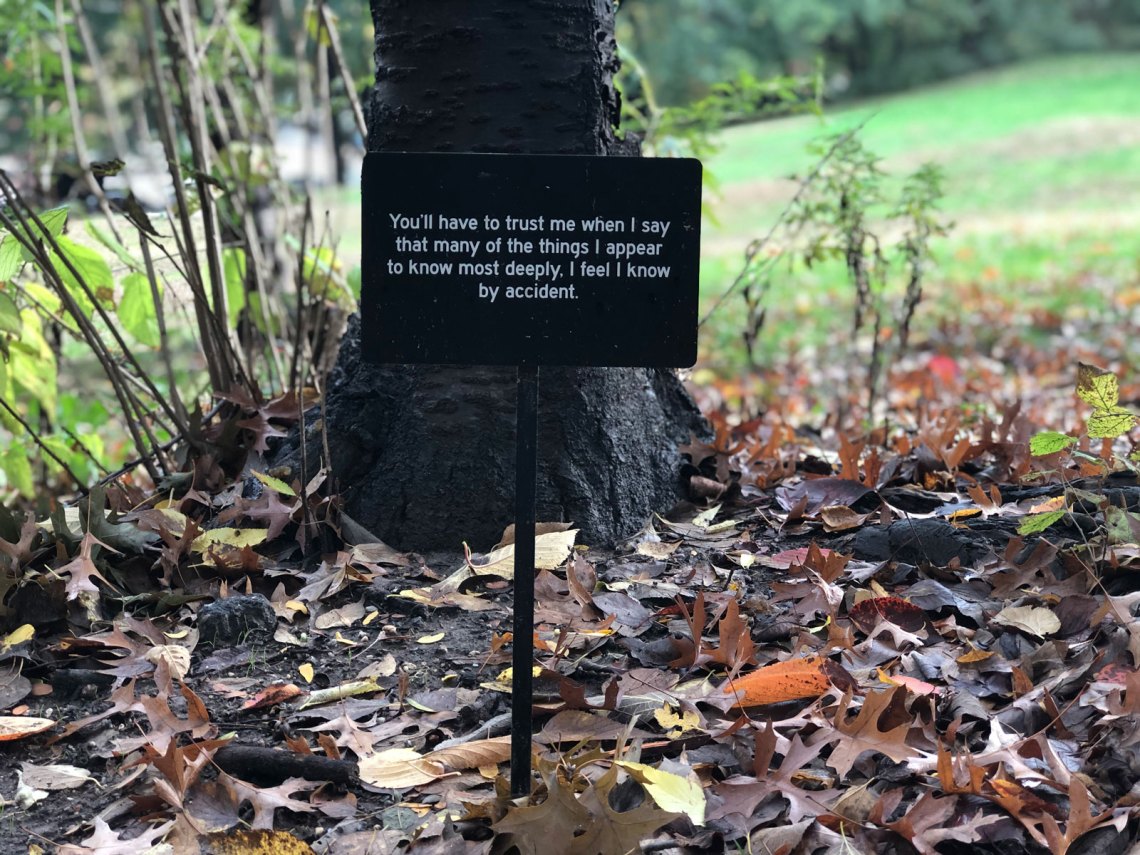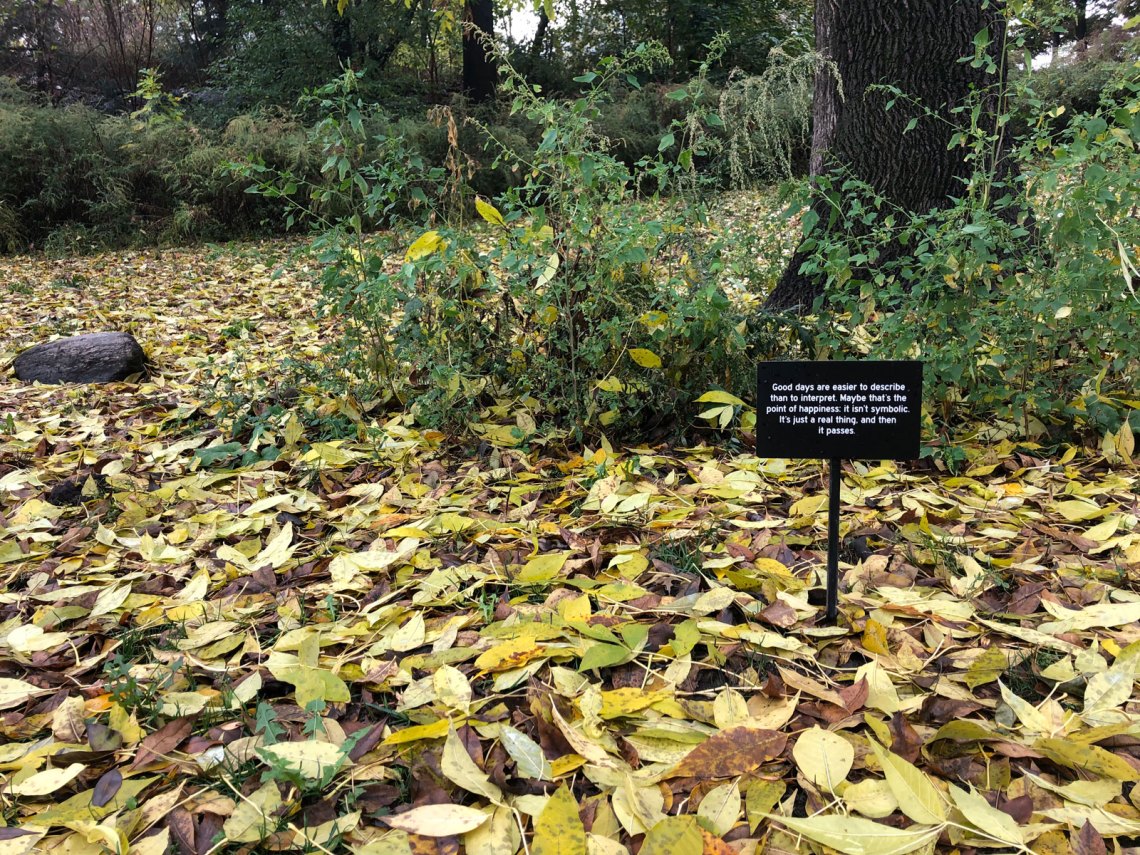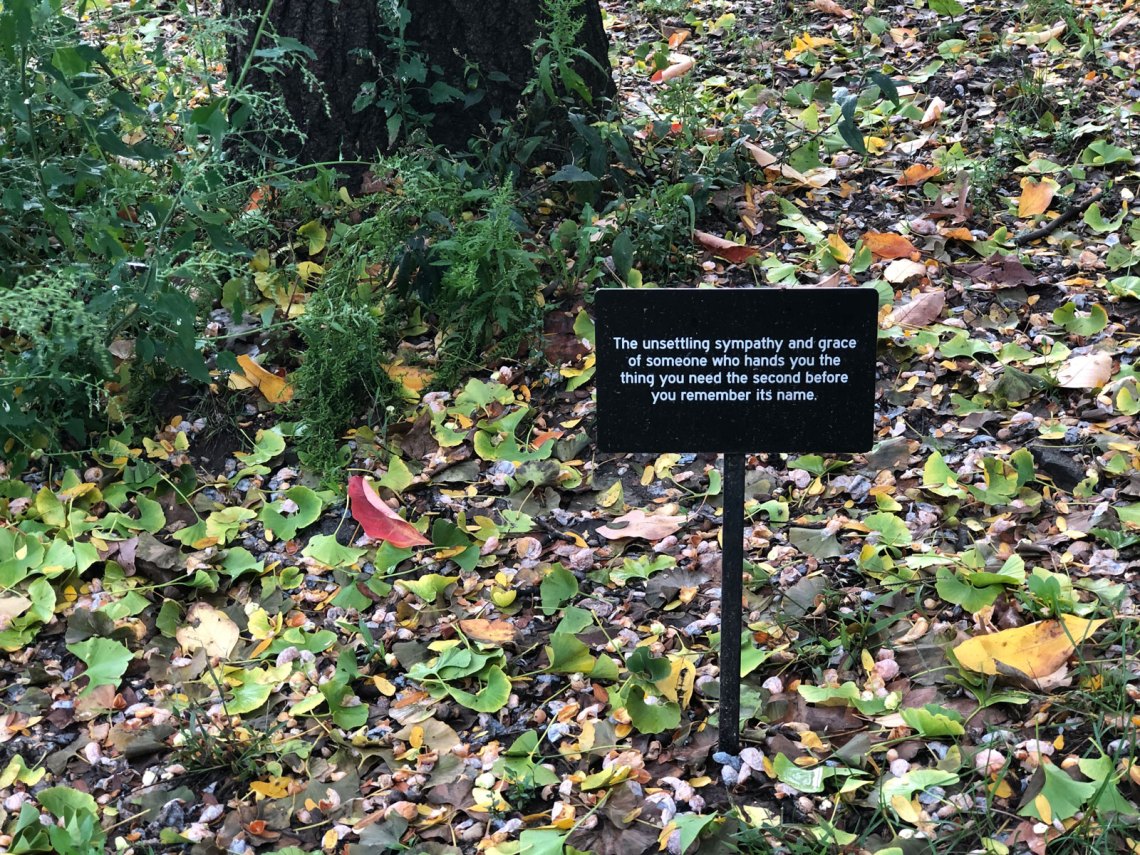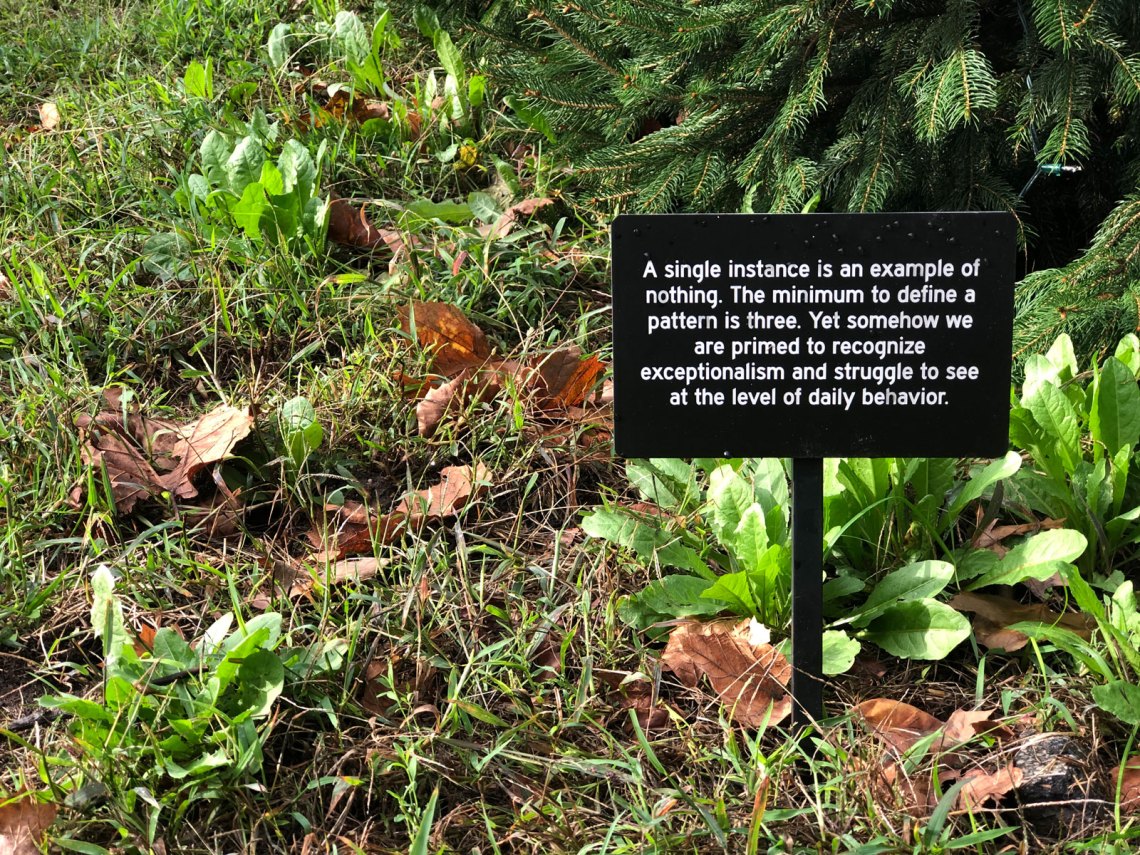I first encountered the work of conceptual artist Chloë Bass in the fall of 2019 while walking to work through Harlem’s St. Nicholas Park. On the sloping hill up to City College, a reflective billboard—a giant mirror—was planted in the grass, with the words “How much of love is attention?” written across it. I felt arrested by the sign because it demanded thought, and also because, the previous fall, I’d been stopped in my tracks by another work of public art that stood in nearly the same spot. That road sign had been by artist Justin Guariglia, and flashed terrifying warnings about climate change. The residue of its message still accrued to that public space in my memory. In fact, it radicalized the way I see the environment.
Though Bass’s signage may not have been in direct conversation with Guariglia’s, the two projects were, to my mind, connected. They even seemed narrated by the same disembodied interrogator, which may as well have been the voice of the park itself, directed at the community. I felt in my body that the answer to Bass’s question about love was that it had entirely to do with attention, especially love of this threatened world. And that, when applied, this attention looked like caring more for one another’s wellbeing. I discovered that this billboard was one of twenty-four sculptural signs of various sizes situated throughout St. Nicholas Park, sponsored by the Studio Museum in Harlem. “Wayfinding” is Bass’s first institutional solo exhibition, and will remain on view through late September.
We exchanged emails about how this project fits into her larger body of work, and how her practice has changed as a result of the global pandemic. Our conversation has been edited and condensed.
Emily Raboteau: Your signs and Justin’s both put me in mind of what theologian Walter Brueggemann has said about prophetic language working like a pickaxe. A fearless truth-telling joined with fierce hope conveyed by disarming language to reframe the social realities confronting us so that we can see them from a different angle. I felt implicated by your question “How much of love is attention?” Do you feel you’re working in a prophetic, poetic, or spiritual tradition?
Chloë Bass: I haven’t read Brueggemann—although now you’re making me want to—but I feel a deep relation between language and tool that his metaphor suggests. I also haven’t had cause to use a pickaxe yet in my life—what does that say about me? Insufficient mining and ice-fishing, I guess—but I have considered language in other similar contexts: the scalpel, the hammer, the needle.
I’m very moved by the dedication of belief, and the way that belief in the best sense can actually open our eyes to the world, and expand our interpretations of the world. A huge part of my art practice is to get people to look more closely at what’s around them, including, but not exclusively, at themselves. To really put that forward into the world requires a huge amount of belief, and belief in what belief itself offers.
Two other mirrored billboards in “Wayfinding” ask, “How much of life is coping?” and “How much of care is patience?” The billboards anchor the exhibition, mirroring Harlem as it transforms over time, reflecting what you’ve observed as “gentrification and the force it enacts on a city in constant flux.” Can you say more about how posing these questions on reflective surfaces in a public park might build a bridge between internal thought and external social and political dialogue?
It’s not a new realization to me that these external locations are both highly social, and extremely politicized. I’ve noticed this as a woman, as a person who identifies as Black, and is perceived in many different ways (a reality I know you and I share), but never as white, and as a person who on her own appears normatively femme, but has also been in visibly queer relationships. All of these identities, and their associated readings by external viewers, mean that public space can be fraught. It’s something we all participate in, but not something that we all experience in the same way.
I’m also really interested in the way that feeling shapes everything that we do. I’m particularly interested in how the phrase “I felt afraid” was used by police so often in 2014–2016 as an excuse for murder that it took on a weird kind of refrain. The internal register is always already part of external social and political dialogue, up to and including the formation of laws. I just want to make that more apparent.
Advertisement
The billboards anchor the project, but there are several smaller wayfinding signs throughout the park with statements considering loss, anxiety, family intimacy, and desire. I enjoyed photographing them when I walked to and from the campus where I teach creative writing, before the college shut down. You’ve described yourself as an arts-based researcher and also as having more training as a writer than an artist. What text-based artists and writers are you influenced by?
As a (former? recovering?) theater person—mostly a director, with some acting, and some creative and critical theatrical writing; and a classical music performer, mostly piano, with some music theory and some voice—and as a person who spent some years producing large-scale public events, I’m most influenced by the elements of performance inherent in everyday life. I like bureaucracy in its funny influence [on our daily lives], and games, and play, and found public text, including signage.
Artistically, I’m definitely influenced by the work of Jenny Holzer, although I think I have a different relationship to rage (stay mad, Jenny!). I appreciate the ways that she engages with the presentation of text in public space particularly, and the variety of materials she’s used (wheatpaste posters, electronic billboards, engraved benches and plaques, to name a few). My crossover academic, performance, and text-based influence is Adrian Piper. I owe a debt to Lorna Simpson’s combinations of photography and text, particularly her notions of captioning, and what the space of the caption can allow.
As a writer, I’m grateful to the people who have opened up room for the crossover between theory, poetry, and personal narrative, most recently Wayne Koestenbaum, Maggie Nelson, and, to some extent, Claudia Rankine. But I spend far more time reading novels, and have learned to write largely from that stylistic position. Arundhati Roy’s The God of Small Things changed my life. There’s a space of invention that a novel can take up directly and honestly: it’s fiction. I don’t feel like other writing spaces, which we classify as nonfiction, can be as honest that they’re a place of invention, too.
We’re now in a protracted public health crisis. It’s a different political moment from when you installed the show. Many of us have lost jobs, family members, neighbors, colleagues, friends, childcare, and the cityscape as we knew it. Public space in New York City has a different meaning. For some of us, the parks have become necessary sites of respite, congregation, and escape from quarantine in small apartments. How do you re-read your project in this moment? How has its meaning changed?
I’m grateful that the project has remained relevant and meaningful for people who view it. [In September 2019] I obviously had no sense, or even any imagining, of what would happen during the year when the work was up. I did know that a year is a long time for any single exhibition, though, and that a year can contain a lot of things, so I wanted to make something that felt impactful enough to be clear, meaningful, and emotionally nuanced, while also allowing for the world around it to change its meaning. This comes back to the use of mirrors, which reflect the world back to itself, rather than stagnating and celebrating a single iconic moment or person. As we’ve seen from all kinds of recent events, the standard issue monument really doesn’t age well!
As people have been walking through “Wayfinding” since March 2020, I’ve been struck by the ways in which many people are finding the project’s statements and questions to be imbued with new meaning because of the pandemic, and in particular the feelings and consequences of social-distancing. The sign that’s come up the most is “The part of you that says, ‘I can share myself with strangers.’” This makes sense to me, because strangers have become risk vectors in a whole new way. “In the absence of perspective, a minute can stretch to contain innumerable fears.” has been coming up a lot, too. Of course, “How much of life is coping?” has been a popular one too, because… yeah.
Coming back to your earlier question about prophecy, while I didn’t intend for the work to have prophetic qualities, I did want it to hit people from different backgrounds, or who have different life experiences, at a variety of emotional registers. If prophecy means a certain type of strong adaptability, or strength in its range of applicable situations, then I hope the project does that.
Advertisement
How has your artistic practice changed, if it has?
My location has changed: I’ve been in St. Louis since March 22, after living in New York my whole life. So the space around me has changed, and the way that I live has changed. But as an artist, things feel fairly similar. Some of my projects have been postponed. I don’t make many physical artworks over the course of a normal year, anyway. A lot of my work is in the purely conceptual realm, and located in my 2011 MacBook Pro rather than in a formal studio.
Other than my series The Parts, an open-ended photo- and text-based Instagram art project, I did recently produce my first new physical artwork since the shutdown: a sixteen-part photo and text piece that’s currently on view at Standard Space in Sharon, Connecticut. I’ve also recently finished a new video essay and a performance lecture, both of which premiered late last month.
The only thing my artistic practice has been missing is my usual deep engagement with the outside world. I spend a lot of time eavesdropping as a creative practice. That’s obviously gone. I do take a lot of walks here in St. Louis, and I’m grateful for what’s left, both in terms of opportunity and observation. I do miss the feeling of being mildly aroused in museums. Or crowds. Or on public transportation. I don’t know how to drive. I hope I can eventually find a similar creative impulse from being shotgun in the car that I do from my time on subways and buses.
We’re both professors at CUNY, the largest urban public university system in the country, an institution that’s been particularly hard hit by the virus. Several faculty and staff members have died. The budget was mercilessly slashed. A fifth of the adjuncts were laid off, many of them losing their health coverage. Tuition is likely going up, even as the quality of instruction via remote learning has arguably gone down. How has your teaching evolved during this crisis as a professor of art and social practice?
I’m not just a professor at CUNY, I’m a CUNY lifer. I went to the Hunter College Campus Schools from pre-K through twelfth grade, and returned to do my MFA in Performance and Interactive Media Arts at Brooklyn College. I was an adjunct at Brooklyn for a year, then received a full-time position in the Art Department at Queens College in 2016. So, in a lot of ways, CUNY and the public university system has been my third parent.
CUNY has also shaped a lot of my thinking about “the public,” particularly what allows some publics to succeed and what can force them to fail. The pandemic has forced a lot of reconsideration around participation: there’s a public health crisis if we participate too much, and an economic crisis if we don’t. CUNY lies at the intersection of these two crises, and I’m truly afraid to see how this convergence will simultaneously fail us in both directions.
I don’t want to see any public space forced to fail. I believe this is preventable. I also believe it will still require huge measures of participation in order to succeed, and that we need to be very nimble, generous, and wild-thinking with what those forms of participation might be. Money, for sure, would help. But what other protections can we offer that will allow people to deeply engage with one another in a relatively democratic educational space?
For my own part, I think that the social aspect of social practice is going to have more heft than the art aspect for the next few years. It’s not that I don’t believe in art, but I think our consideration of sociality, and how to maintain it, is being more deeply and interestingly questioned through our lived experiences at present.
Your artist statement tells us your work uses “daily life as a site of deep research to address scales of intimacy: where patterns hold and break as group sizes expand.” The Bureau of Self-Recognition (2011–2013), focused on the individual. The Book of Everyday Instruction (2015–2018) studied pairs. My understanding is that “Wayfinding” is an unfinished part of a larger project called Obligation to Others Holds Me in My Place, about intimacy at the scale of immediate families, initially focused on American mixed-race families like yours and mine. The next phase of this project was to be a play you’d hoped to perform this spring or summer. Were your plans disrupted and redirected by the pandemic?
Yes, “Wayfinding” is one part of Obligation to Others Holds Me in My Place. When I designed the installation for St. Nicholas Park, I meant for it to be an exhibition, but also to serve as the set for the play. The play is actually the only aspect of my work that’s been outright cancelled due to the lockdown. Maybe I’ll be able to use [the research and preparation for it] in a different way in the future.
The larger Obligation to Others project is continuing, although some of the plans for its next phases have been disrupted as well. I was supposed to start shooting a four-channel experimental documentary right at the time of lockdown. All of the shoots would take place in the homes of mixed-race American families who were inviting me and my crew in to document their special occasions. It’s hard to say when it will feel safe to travel, or when we’ll be easily able to be in strangers’ homes again.
Still, I’m finding other ways to shift the project’s outcomes. New elements of work are being supported through the CUNY Center for the Humanities through the Seminar on Public Engagement, as well as through the Brooklyn Public Library, in 2021.
Is your ambition still to work up gradually to a project about intimacy at the scale of the metropolis? Do you feel intimacy has contracted in the city as a result of quarantine?
At the beginning of shelter-in-place, I kept seeing so many posts on social media from people who were completely isolated, and at the time when they were saying, “wow, I’m so alone,” I was feeling [of my own social-distancing pod] like, “wow, we’re so together.” A friend of mine who has largely been sheltering on her own pointed out to me that, regardless of anyone’s circumstance, what they have during this period is too much of it: too much loneliness or too much togetherness.
I don’t know what this will mean for intimacy in New York City (or anywhere) in the longer term, but I do think it’s important for us to keep in mind that people’s experiences of this crisis, while shared, cannot be presumed to be the same.
“Wayfinding,” presented by Harlem’s Studio Museum, is on view at St. Nicholas Park through September 27. An accompanying essay by Chloë Bass is published by ARTS.BLACK.


